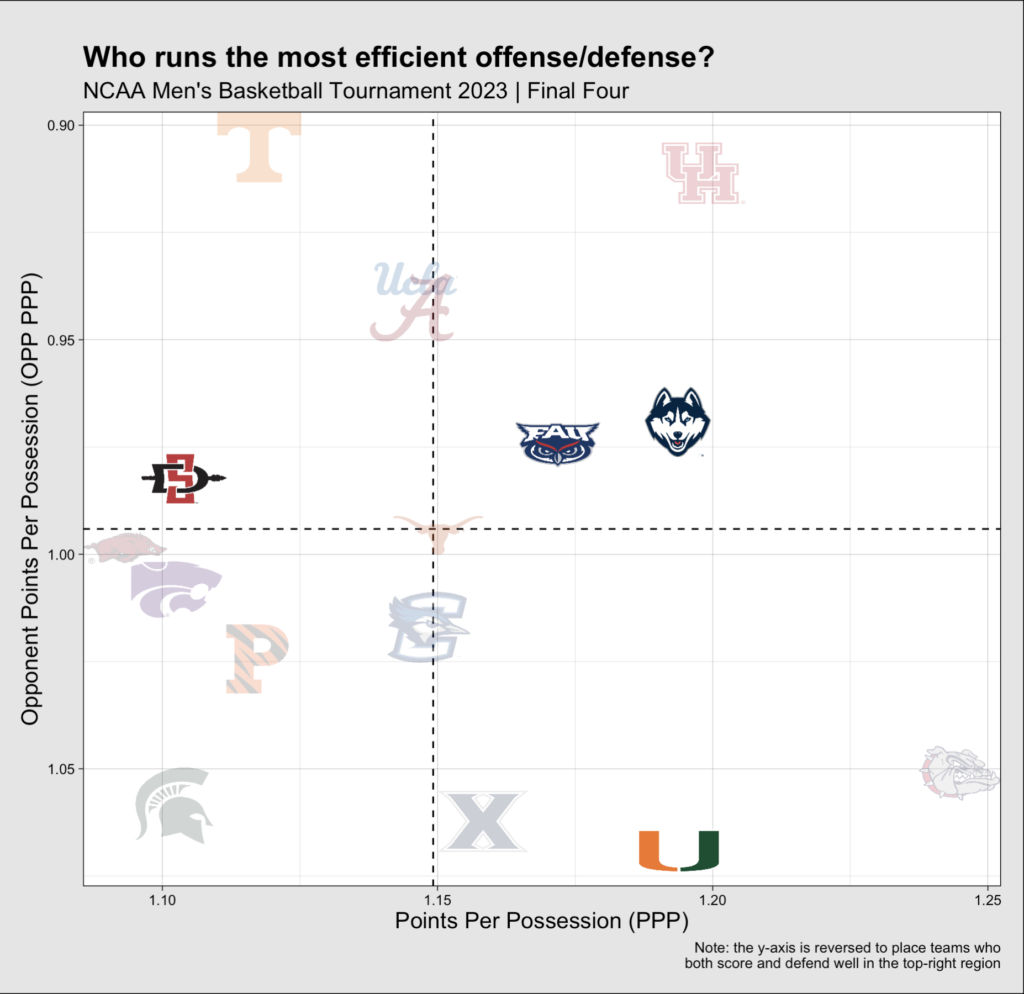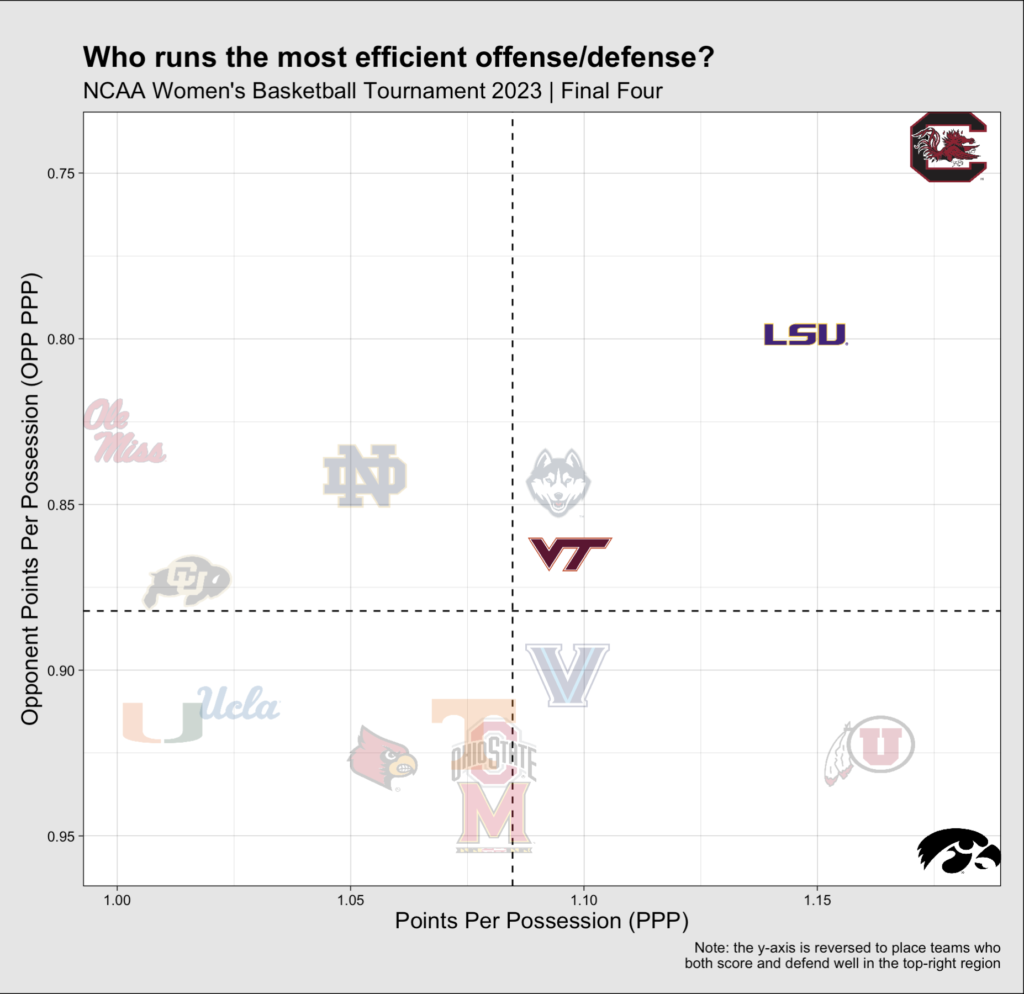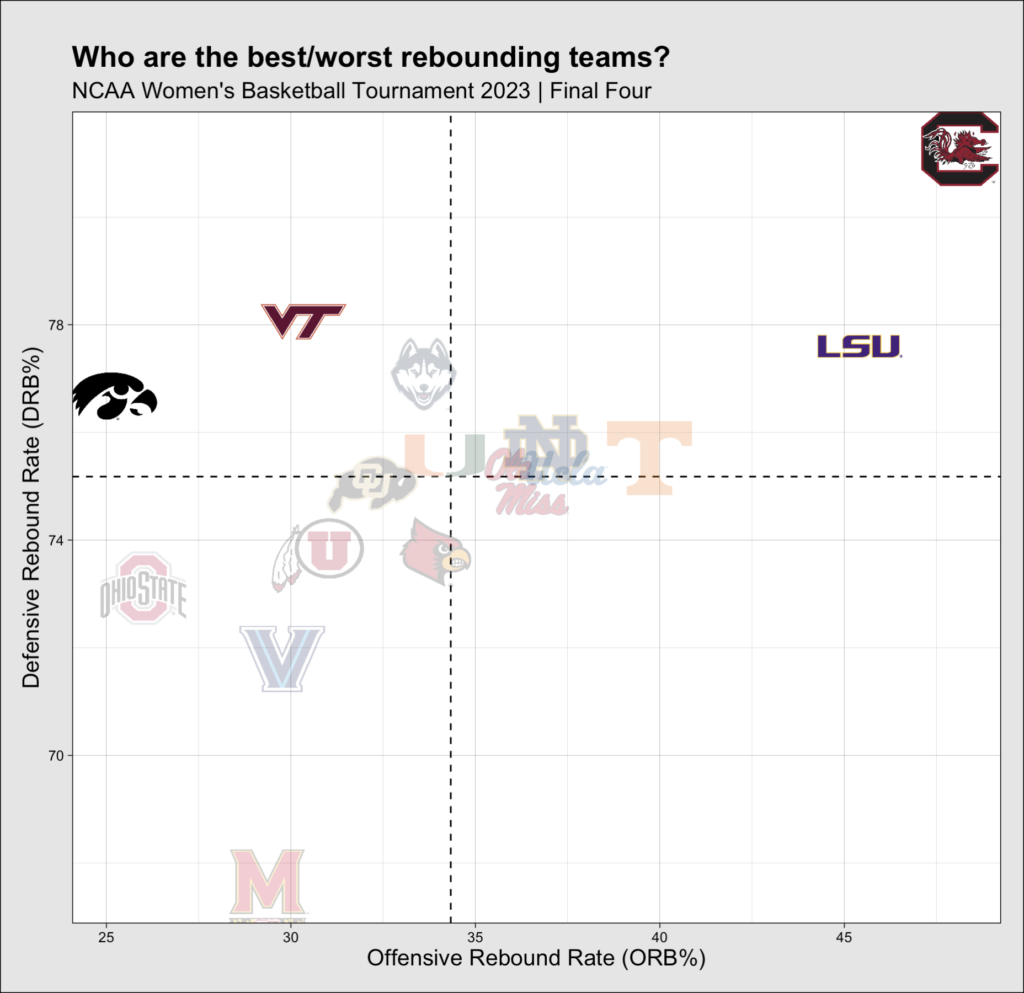Previewing the Final Four Without Watching Any Film
April, 2023
Introduction

* A clear example of misleading box scores is the effect of pace on turnover counts. If a team commits 10 turnovers against Team 1 and only 15 against Team 2, naturally you might assume that Team 2 is the scrappier team since they forced more turnovers. But if Team 2 actually just plays at a faster pace – more possessions generally equals more turnovers – then there’s really more nuance to the disparity we’re seeing.
Men's Tournament Preview
- They score an impressive 1.19 points per possession and own the second-highest PPP differential among the Sweet 16 pool
- What kinds of shots do they attempt the most (e.g. pull-up, catch-and-shoot)?
- They shoot a relatively high amount of threes
- How do they generate so many threes (e.g. flare screens, post kicks)?
- They keep opponents off the three-point and free-throw lines at the third-lowest and second-lowest rates
- Which defensive principles contribute to this (e.g. prevent middle, show-and-recover)?
- They own the highest offensive and defensive rebound rates
- They protect the ball better than any remaining Final Four team
- In games that they’ve turned it over at a higher rate, what were their opponents doing differently?
- They score and allow above the average points per possession among the Sweet 16 pool
- What kinds of shots do they attempt the most (e.g. pull-up, catch-and-shoot)?
- What kinds of shots do they allow the most (e.g. pull-up, catch-and-shoot)?
- They take the second-most threes (by frequency)
- How do they generate so many threes (e.g. flare screens, post kicks)?
- They don’t live at the free-throw line but neither do their opponents
- How crucial is getting to the line – or winning the free-throw differential – to their success?
- They score an efficient 1.19 points per possession
- What kind of shots do they attempt the most (e.g. pull-up, catch-and-shoot)?
- They rank dead last in points allowed per possession and allow the second highest free-throw rate
- What kind of shots do they allow the most (e.g. pull-up, catch-and-shoot)?
- What is leading to committing so many shooting fouls (e.g. poor technique, late help defense)?
- Despite average offensive rebounding numbers, they’re one of the worst defensive rebounding teams
- San Diego State scores a below-average 1.10 points per possession
- What kinds of shots do they attempt the most (e.g. pull-up, catch-and-shoot)?
- They allow the third-highest three-point attempt rate among the Sweet 16 pool
- How do their opponents generate so many threes (e.g. flare screens, post kicks)?
- Relatively average with respect to free-throw, rebounding, and turnover rates






Women's Tournament Preview
- They attempt threes at the third-highest rate among the Sweet 16 pool
- How do they generate so many threes (e.g. flare screens, post kicks)?
- Only four teams allow a lower free-throw rate
- Why don’t they commit many shooting fouls (e.g. good technique, timely help defense)?
- Despite being a below-average offensive rebounding team, they keep opponents off the offensive glass
- They attempt threes at the third-highest rate among the Sweet 16 pool
- They score the second-most points per possession while allowing the most among the Sweet 16 pool
- What kind of shots do they attempt the most (e.g. pull-up, catch-and-shoot)?
- They own the highest offensive and second-highest defensive three-point frequency
- How do they generate so many threes (e.g. flare screens, post kicks)?
- How do their opponents generate so many threes (e.g. flare screens, post kicks)?
- They own the lowest offensive rebounding rate
- Their opponents turn it over at the lowest frequency
- Why do their opponents protect the possession so well (e.g. no ball pressure)?
- They play great on both ends of the floor and hold the second-best points per possession differential among the Sweet 16 pool
- What kinds of shots do they attempt the most (e.g. pull-up, catch-and-shoot)?
- What kinds of shots do they allow the most (e.g. pull-up, catch-and-shoot)?
- They own the second-lowest three-point frequency but allow above-average three-point frequency
- Are most of their shots coming from the mid-range or from the paint (more drives or post-ups)?
- They get to the free-throw line at a higher rate than any team
- What tendencies help them draw more shooting fouls (attacking closeouts, early post-ups)?
- They rebound extremely well on both ends of the floor
- Their opponents turn it over at the third-highest rate
- How do they force turnovers (e.g. jumping passing lanes, on-ball pressure)?
- They’re the best defensive and second-best offensive team by points per possession among the Sweet 16 pool
- What kinds of shots do they attempt the most (e.g. pull-up, catch-and-shoot)?
- What kinds of shots do they allow the most (e.g. pull-up, catch-and-shoot)?
- They attempt the lowest three-point frequency while drawing shooting fouls at an above-average rate
- Are most of their shots coming from the mid-range or from the paint (more drives or post-ups)?
- Their opponents attempt the second-lowest three-point frequency and they commit shooting fouls at a below-average rate
- Are most of their opponents’ shots coming from the mid-range or from the paint (more drives or post-ups)?
- On paper, they are the best offensive and defensive rebounding team and it’s not even close
- Their opponents turn it over at the second-lowest rate
- For such a great defensive team, why aren’t they forcing more turnovers?






Completing the Scouting Report
- Using the preliminary analyses above as a starting point, start watching film with specific points of emphasis in mind (e.g. three-point defense)
- Find how the numbers and the eye-test agree and disagree. Sure, UConn might turn it over a lot, but maybe this is because they move the ball so well and occasionally over-pass (i.e. everything comes with context).
Iowa can certainly give South Carolina problems since they shoot threes with high volume and efficiency, but…
South Carolina is the easy pick, since they’re undefeated this season and are simply dominant. They recover nearly 50% of their misses (insane) and are overall really strong inside of the arc on both ends of the floor.
Their opposing style of play is what makes this matchup so intriguing – not to mention the Aliyah Boston vs Caitlin Clark matchup – and their defensive execution on the three-point line is going to be key for stopping Iowa’s offense.
My Prediction: South Carolina
LSU and Virginia Tech’s three-point styles actually align pretty interestingly. LSU doesn’t shoot many threes but allows a decent amount, and VTech prevents threes and shoots a lot of threes.
If VTech catches fire from deep, they’ll have a great chance of winning, but on paper, LSU looks like the better team – they might just dominate the boards and take advantage of second-chance points.
My Prediction: LSU
For a few of UConn’s potential weaknesses, Miami comes up short. UConn shoots a lot of threes, but Miami doesn’t quite run opponents off the line extremely well. UConn relatively doesn’t protect the ball well, but Miami doesn’t force many turnovers.
And on the boards, UConn will dominate Miami. They’re the best offensive rebounding team and Miami is one of the worst defensive rebounding teams. They’re coming off essentially 4 tournament blowouts, and I’m can’t see Miami pulling off an upset unless they can stop UConn’s offense (Miami allows the most points per possession).
My Prediction: UConn
(If UConn advances, I’ll win all of the Bracket Challenge groups I’m in, so clearly no bias here)
SDSU gives up a lot of threes and FAU could really take advantage of that, but the opposite could be said about SDSU’s inside game. Neither team stands out as the better rebounding or more disciplined team – in terms of committing or forcing turnovers – so this game could be a toss-up.
My Prediciton: FAU
Conclusion
I based my preliminary analysis here off of the work that I’ve done as an Analytics Intern for the University of Chicago Men’s and Women’s Basketball Teams. What I’ve shown above only constitutes a fraction of the type of scouting reports I’ve written, and a more complete report would – more or less – include actual numbers to answer some of the questions I’ve asked as well as specialized offensive personnel scouts. For example, to assess how Iowa generates their three-point looks, I would watch every three-point attempt from the last few weeks, manually record the play type, and present the data in the form of a table in my report.
What I’ve identified for myself as one of the hardest but most important components of scouting is knowing what the right questions to ask are and when to ask them, especially when the eye test and the numbers clash with each other. For specific matchups, I might not care about how UConn generates threes; what I really want to know is how they attack closeouts, since I know that my team excels at preventing threes. There are levels of nuance behind every play, every stat, and every decision, and learning how to isolate strategies to give your team the best chance of winning is a really fun and unique challenge to take on.
